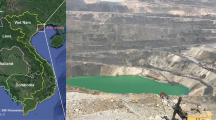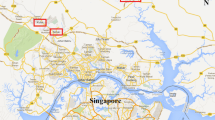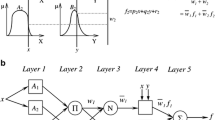Abstract
This research presents several non-linear models including empirical, artificial neural network (ANN), fuzzy system and adaptive neuro-fuzzy inference system (ANFIS) to estimate air-overpressure (AOp) resulting from mine blasting. For this purpose, Miduk copper mine, Iran was investigated and results of 77 blasting works were recorded to be utilized for AOp prediction. In the modeling procedure of this study, results of distance from the blast-face and maximum charge per delay were considered as predictors. After constructing the non-linear models, several performance prediction indices, i.e. root mean squared error (RMSE), variance account for (VAF), and coefficient of determination (R 2) and total ranking method are examined to choose the best predictive models and evaluation of the obtained results. It is obtained that the ANFIS model is superior to other utilized techniques in terms of R 2, RMSE, VAF and ranking herein. As an example, RMSE values of 5.628, 3.937, 3.619 and 2.329 were obtained for testing datasets of empirical, ANN, fuzzy and ANFIS models, respectively, which indicate higher performance capacity of the ANFIS technique to estimate AOp compared to other implemented methods.













Similar content being viewed by others
References
Bhandari S (1997) Engineering rock blasting operations. A.A. Balkema, Netherlands
Shirani Faradonbeh R, Monjezi M, Jahed Armaghani D (2015) Genetic programing and non-linear multiple regression techniques to predict backbreak in blasting operation. Eng Comput. doi:10.1007/s00366-015-0404-3
Hemphill GB (1981) Blasting operations. McGraw-Hill, New York
Khandelwal M, Singh TN (2007) Evaluation of blast-induced ground vibration predictors. Soil Dynamic Earthq Eng 27:116–125
Monjezi M, Bahrami A, Yazdian Varjani A (2010) Simultaneous prediction of fragmentation and flyrock in blasting operation using artificial neural networks. Int J Rock Mech Min Sci 47:476–480
Hajihassani M, Jahed Armaghani D, Sohaei H, Tonnizam Mohamad E, Marto A (2014) Prediction of airblast-overpressure induced by blasting using a hybrid artificial neural network and particle swarm optimization. Appl Acoust 80:57–67
Khandelwal M, Singh TN (2009) Prediction of blast-induced ground vibration using artificial neural network. Int J Rock Mech Min Sci 46:1214–1222
Ebrahimi E, Monjezi M, Khalesi MR, Jahed Armaghani D (2015) Prediction and optimization of back-break and rock fragmentation using an artificial neural network and a bee colony algorithm. Bull Eng Geol Environ. doi:10.1007/s10064-015-0720-2
Saghatforoush A, Monjezi M, Faradonbeh RS, Jahed Armaghani D (2015) Combination of neural network and ant colony optimization algorithms for prediction and optimization of flyrock and back-break induced by blasting. Eng Comput. doi:10.1007/s00366-015-0415-0
Hasanipanah M, Monjezi M, Shahnazar A, Jahed Armaghani D, Farazmand A (2015) Feasibility of indirect determination of blast induced ground vibration based on support vector machine. Measurement 75:289–297
Kuzu C (2008) The importance of site-specific characters in prediction models for blast-induced ground vibrations. Soil Dyn Earthq Eng 28:405–414
Kuzu C, Fisne A, Ercelebi SG (2009) Operational and geological parameters in the assessing blast induced airblast-overpressure in quarries. Appl Acoust 70:404–411
Rodríguez R, Lombardía C, Torno S (2010) Prediction of the air wave due to blasting inside tunnels: approximation to a ‘phonometric curve’. Tunn Undergr Sp Technol 25:483–489
Roy PP (2005) Rock blasting effects and operations. A.A Balkema, India
Siskind DE, Stachura VJ, Stagg MS, Koop JW (1980). In: Siskind DE (ed) Structure response and damage produced by airblast from surface mining. United States Bureau of Mines
Khandelwal M, Kankar PK (2011) Prediction of blast-induced air overpressure using support vector machine. Arabian J Geosci 4:427–433
Dowding CH (2000) Construction vibrations. In: Dowding (ed), pp 204–207
Segarra P, Domingo JF, López LM, Sanchidrián JA, Ortega MF (2010) Prediction of near field overpressure from quarry blasting. Appl Acoust 71:1169–1176
Jahed Armaghani D, Hajihassani M, Sohaei H, Mohamad ET, Marto A, Motaghedi H, Moghaddam MR (2015) Neuro-fuzzy technique to predict air-overpressure induced by blasting. Arabian J Geosci. doi:10.1007/s12517-015-1984-3
National Association of Australian State Road Authorities (1983) Explosives in Roadworks: a Users Guide. NAASRA, Sydney
McKenzie C (1990) Quarry blast monitoring: technical and environmental perspectives. Quarry Manag 17:23–34
Hustrulid WA (1999) Blasting principles for open pit mining: general design concepts. Balkema
Jahed Armaghani D, Hasanipanah M, Mohamad ET (2015) A combination of the ICA-ANN model to predict air overpressure resulting from blasting. Eng Comput. doi:10.1007/s00366-015-0408-z
Rodríguez R, Toraño J, Menéndez M (2007) Prediction of the airblast wave effects near a tunnel advanced by drilling and blasting. Tunn Undergr Sp Technol 22:241–251
Afeni BT, Osasan KS (2009) Assessment of noise and ground vibration induced during blasting operations in an open pit mine-A case study on Ewekoro limestone quarr, Nigeriay. Min Sci Tech 19:420–424
Ceryan N, Okkan U, Kesimal A (2013) Prediction of unconfined compressive strength of carbonate rocks using artificial neural networks. Environ Earth Sci 68:807–819
Jahed Armaghani D, Tonnizam Mohamad E, Momeni E, Narayanasamy MS, Mohd Amin MF (2014) An adaptive neuro-fuzzy inference system for predicting unconfined compressive strength and young’s modulus: a study on main range granite. Bull Eng Geol Environ. doi:10.1007/s10064-014-0687-4
Shams S, Monjezi M, Majd VJ, Jahed Armaghani D (2015) Application of fuzzy inference system for prediction of rock fragmentation induced by blasting. Arabian J Geosci. doi:10.1007/s12517-015-1952-y
Gordan B, Jahed Armaghani D, Hajihassani M, Monjezi M (2015) Prediction of seismic slope stability through combination of particle swarm optimization and neural network. Eng Comput. doi:10.1007/s00366-015-0400-7
Jahed Armaghani D, Mohamad ET, Hajihassani M, Yagiz S, Motaghedi H (2015) Application of several non-linear prediction tools for estimating uniaxial compressive strength of granitic rocks and comparison of their performances. Eng Comput. doi:10.1007/s00366-015-0410-5
Jahed Armaghani D, Raja Shoib RSNS, Faizi K, Rashid ASA (2015) Developing a hybrid PSO-ANN model for estimating the ultimate bearing capacity of rock-socketed piles. Neural Comput Appl. doi:10.1007/s00521-015-2072-z
Jahed Armaghani D, Hajihassani M, Marto A, Faradonbeh RS, Mohamad ET (2015) Prediction of blast-induced air overpressure: a hybrid AI-based predictive model. Environ Mon Assess 187(11):1–13
Khandelwal M, Singh TN (2005) Prediction of blast induced air overpressure in opencast mine. Noise Vib Control Worldw 36:7–16
Mohamed MT (2011) Performance of fuzzy logic and artificial neural network in prediction of ground and air vibrations. Int J Rock Mech Min Sci 48:845–851
Hajihassani M, Jahed Armaghani D, Monjezi M, Mohamad ET, Marto A (2015) Blast-induced air and ground vibration prediction: a particle swarm optimization-based artificial neural network approach. Environ. Earth Sci. doi:10.1007/s12665-015-4274-1
Tonnizam Mohamad E, Hajihassani M, Jahed Armaghani D, Marto A (2012) Simulation of blasting-induced air overpressure by means of artificial neural networks. Int Rev Modell Simulations 5:2501–2506
Shahin MA, Maier HR, Jaksa MB (2002) Predicting settlement of shallow foundations using neural networks. J Geotech Geoenviron Eng 128:785–793
Simpson PK (1990) Artificial neural system: foundation, paradigms, applications and implementations. Pergamon, New York
Haykin S (1999) Neural networks, 2nd edn. Prentice-Hall, Englewood Cliffs
Monjezi M, Hasanipanah M, Khandelwal M (2013) Evaluation and prediction of blast-induced ground vibration at Shur River Dam, Iran, by artificial neural network. Neural Comput Appl 22:1637–1643
Du KL, Lai AKY, Cheng KKM, Swamy MNS (2002) Neural methods for antenna array signal processing: a review. Signal Process 82:547–561
Kalinli A, Acar MC, Gunduz Z (2011) New approaches to determine the ultimate bearing capacity of shallow foundations based on artificial neural networks and ant colony optimization. Eng Geol 117:29–38
Dreyfus G (2005) Neural Networks: methodology and application, 2nd edn. Springer, Berlin Heidelberg
Fausett LV (1994) Fundamentals of neural networks: architecture, algorithms and applications. Prentice-Hall, Englewood Cliffs
Zadeh LA (1965) Fuzzy sets. Inf Control 8:338–353
Wang LX (1997) A course in fuzzy systems and control. Prentice Hall, Englewood Cliffs, p 424
Jang RJS, Sun CT, Mizutani E (1997) Neuro-fuzzy and soft computing. Prentice-Hall, Upper Saddle River, p 614
Cordon O, Herrera F, Haffmann F, Magdalena L (2001) Genetic fuzzy systems: evolutionary tuning and learning of fuzzy knowledge bases. World Scientific, p 462
Ross TJ (2004) Fuzzy Logic for engineering applications, 2nd edn. John Wiley & Sons, New York, p 628
Jang RJS (1993) Anfis: adaptive-network-based fuzzy inference system. IEEE Trans Syst Man Cybern 23:665–685
Gokceoglu C, Yesilnacar E, Sonmez H, Kayabasi A (2004) A neuro-fuzzy model for modulus of deformation of jointed rock masses. Comput Geotech 31:375–383
Sezer EA, Nefeslioglu HA, Gokceoglu C (2014) An assessment on producing synthetic samples by fuzzy C-means for limited number of data in prediction models. Appl Soft Comput 24:126–134
Jin Y, Jiang J (1999) Techniques in neural-network based fuzzy system identification and their application to control of complex systems. Fuzzy theory systems, techniques and applications. Academic Press, New York, pp 112–128
Sugeno M (1985) Industrial applications of fuzzy control. Elsevier, Amsterdam
Wang YM, Elhag T (2008) An adaptive neuro-fuzzy inference system for bridge risk assessment. Expert Syst Appl 34:3099–3106
Kargar M, Khorasani N, Karami M, Rafiee GH, Naseh R (2012) Statistical source identification of major and trace elements in groundwater downward the tailings dam of Miduk Copper Complex. Kerman, Iran, Environ Monit Assess 184:6173–6185
Swingler K (1996) Applying neural networks: a practical guide. Academic Press, New York
Looney CG (1996) Advances in feed-forward neural networks: demystifying knowledge acquiring black boxes. IEEE T Knowl Data En 8:211–226
Nelson M, Illingworth WT (1990) A practical guide to neural nets. Addison-Wesley, Reading MA
SPSS Inc (2007) SPSS for windows (Version 16.0). SPSS Inc, Chicago
Hush DR (1989) Classification with neural networks: a performance analysis. In: Proceedings of the IEEE International Conference on Systems Engineering. Dayton, pp 277–80
Kanellopoulas I, Wilkinson GG (1997) Strategies and best practice for neural network image classification. Int J Remote Sens 18:711–725
Atici U (2011) Prediction of the strength of mineral admixture concrete using multivariable regression analysis and an artificial neural network. Expert Sys Appl 38:9609–9618
Ornek M, Laman M, Demir A, Yildiz A (2012) Prediction of bearing capacity of circular footings on soft clay stabilized with granular soil. Soil Found 52:69–80
Momeni E, Jahed Armaghani D, Hajihassani M, Amin MFM (2015) Prediction of uniaxial compressive strength of rock samples using hybrid particle swarm optimization-based artificial neural networks. Measurement 60:50–63
Hecht-Nielsen R (1987) Kolmogorov’s mapping neural network existence theorem. In: Proceedings of the First IEEE International Conference on Neural Networks, San Diego, pp 11–14
Hornik K, Stinchcombe M, White H (1989) Multilayer feedforward networks are universal Approximators. Neural Networks 2:359–366
Baheer I (2000) Selection of methodology for modeling hysteresis behavior of soils using neural networks. J Comput Aid Civil Infrastruct Eng 5:445–463
Yagiz S, Gokceoglu C, Sezer E, Iplikci S (2009) Application of two non-linear prediction tools to the estimation of tunnel boring machine performance. Eng Appl Artif Intel 22:808–814
Sonmez H, Gokceoglu C, Nefeslioglu HA, Kayabasi A (2006) Estimation of rock modulus: for intact rocks with an artificial neural network and for rock masses with a new empirical equation. Int J Rock Mech Min Sci 43:224–235
Caudill M (1988) Neural networks primer part III. Al Expert 3:53–59
Ripley BD (1993) Statistical aspects of neural networks. In: Barndoff-Neilsen OE, Jensen JL, Kendall WS (eds) Networks and chaos-statistical and probabilistic aspects. Chapman & Hall, London, pp 40–123
Paola JD (1994) Neural network classification of multispectral imagery. MSc thesis, The University of Arizona
Wang C (1994) A theory of generalization in learning machines with neural application. PhD thesis, The University of Pennsylvania
Masters T (1994) Practical neural network recipes in C++. Academic Press, Boston
Kaastra I, Boyd M (1996) Designing a neural network for forecasting financial and economic time series. Neurocomputing 10:215–236
Demuth H, Beale M, Hagan M (2009) Neural network toolbox: user’s guide. Mathworks, MA
Zorlu K, Gokceoglu C, Ocakoglu F, Nefeslioglu HA, Acikalin S (2008) Prediction of uniaxial compressive strength of sandstones using petrography-based models. Eng Geol 96:141–158
Acknowledgments
The authors would like to extend their appreciation to manager, engineers and personnel of Miduk copper complex for providing the needed information and facilities that made this research possible.
Author information
Authors and Affiliations
Corresponding author
Rights and permissions
About this article
Cite this article
Hasanipanah, M., Jahed Armaghani, D., Khamesi, H. et al. Several non-linear models in estimating air-overpressure resulting from mine blasting. Engineering with Computers 32, 441–455 (2016). https://doi.org/10.1007/s00366-015-0425-y
Received:
Accepted:
Published:
Issue Date:
DOI: https://doi.org/10.1007/s00366-015-0425-y




